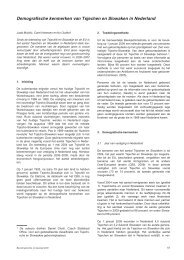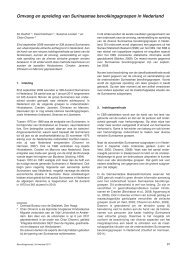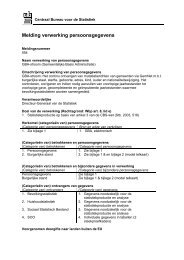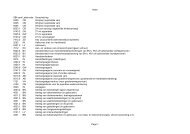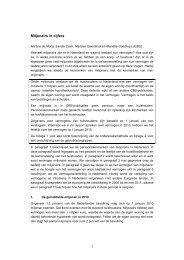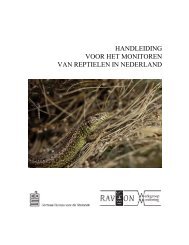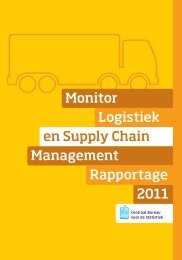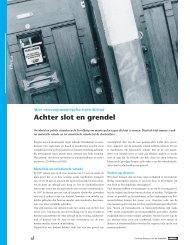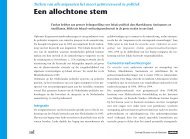Methoden voor de berekening van de emissies door mobiele ... - CBS
Methoden voor de berekening van de emissies door mobiele ... - CBS
Methoden voor de berekening van de emissies door mobiele ... - CBS
Create successful ePaper yourself
Turn your PDF publications into a flip-book with our unique Google optimized e-Paper software.
shown in Table 1.19A. The emission factors originate from the fact sheet "emissions of brake linings"<br />
drawn up by the Centre for Water Management of the Ministry of Public Works and Water<br />
Management. [ref 107: CWM]. It is assumed that the material emitted from brake linings is comprised for<br />
49% of particulate matter (PM10) and for 20% of larger fragments. The remain<strong>de</strong>r of the material (31%)<br />
remains "on the vehicle".<br />
The share of PM2,5 in PM10 is estimated 15% (see table 1.42).<br />
Wear of road surface caused by road vehicles<br />
The emissions of road particulate matter are calculated in the same way as the emissions of tyre and<br />
brake lining particulate matter. To link up with the earlier estimates of total road wear [WSV, 1994] it is<br />
assumed that the emission of road particulate matter is 1.6 times as large as that of tyre particulate<br />
matter emission. This factor is assumed to be in<strong>de</strong>pen<strong>de</strong>nt of the statistical year. For the emission<br />
factors is referred to Table 1.15. In the same way as with tyre wear, it is assumed that 5% of the road<br />
particulate matter emission comprises particulate matter (PM10) and that the remain<strong>de</strong>r therefore<br />
comprises larger fragments.<br />
The share of PM2,5 in PM10 is estimated 15% (see table 1.42)<br />
Figure 1.5 Calculating emissions from road traffic, emissions of particulate matter (PM10)<br />
caused by wear of tyres, brake linings and road surfaces<br />
EMISSION FACTORS<br />
total wear <strong>de</strong>bris mg/vehicle km<br />
per vehicle category<br />
EMISSIONS total wear <strong>de</strong>bris<br />
1000 kg<br />
per<br />
- vehicle category<br />
- fuel type<br />
- road type<br />
EMISSIONS particulate matter<br />
per<br />
- vehicle category<br />
- fuel type<br />
- road type<br />
1000 kg<br />
VEHICLE<br />
KILOMETRES<br />
per<br />
- vehicle category<br />
- fuel type<br />
- road type<br />
PROFILES<br />
particulate matter/<br />
larger <strong>de</strong>bris<br />
Wear of tyres, brakes and road surfaces; heavy metals and PAHs<br />
Heavy metals in tyre particulate matter emission<br />
The emissions of heavy metals caused by tyre wear are calculated by applying a profile of the<br />
composition of the total tyre material. This composition is shown in Table 1.29B. The heavy metals<br />
trapped in particulate matter are emitted to the air because it is assumed that 100% of particulate<br />
matter remains airborne. Heavy metals trapped in coarse particles fall back to the soil or the surface<br />
water. Within the urban area, it is assumed that 100% of coarse particles end up in water. Outsi<strong>de</strong> the<br />
urban area, a figure of 10% is used, and therefore 90% end up in the soil [ref 118: RWS Centre for Water<br />
Management].<br />
Heavy metals in brake particulate matter emission<br />
The emissions of heavy metals caused by the wear of brake linings are calculated by applying a profile<br />
of the composition of brake lining material. The composition profile is shown in Table 1.29B. This table<br />
is <strong>de</strong>rived from Table 6 of the fact sheet "emissions from brake linings" [ref 107: RWS Centre for Water<br />
Management]. For the allocation of the emissions of heavy metals to soil and water as a result of brake<br />
lining wear, the same percentages are used as with tyre wear emissions.<br />
21





